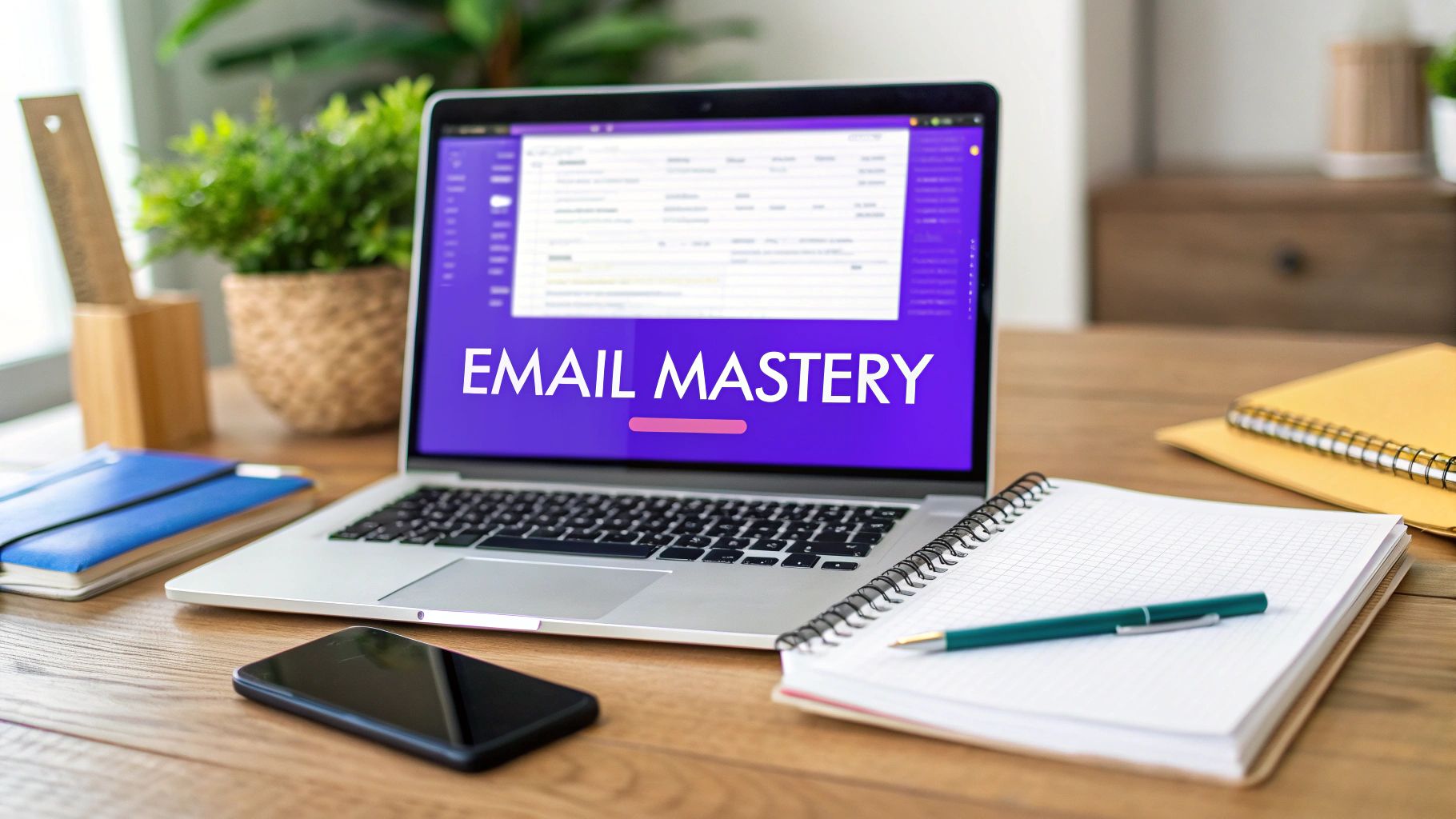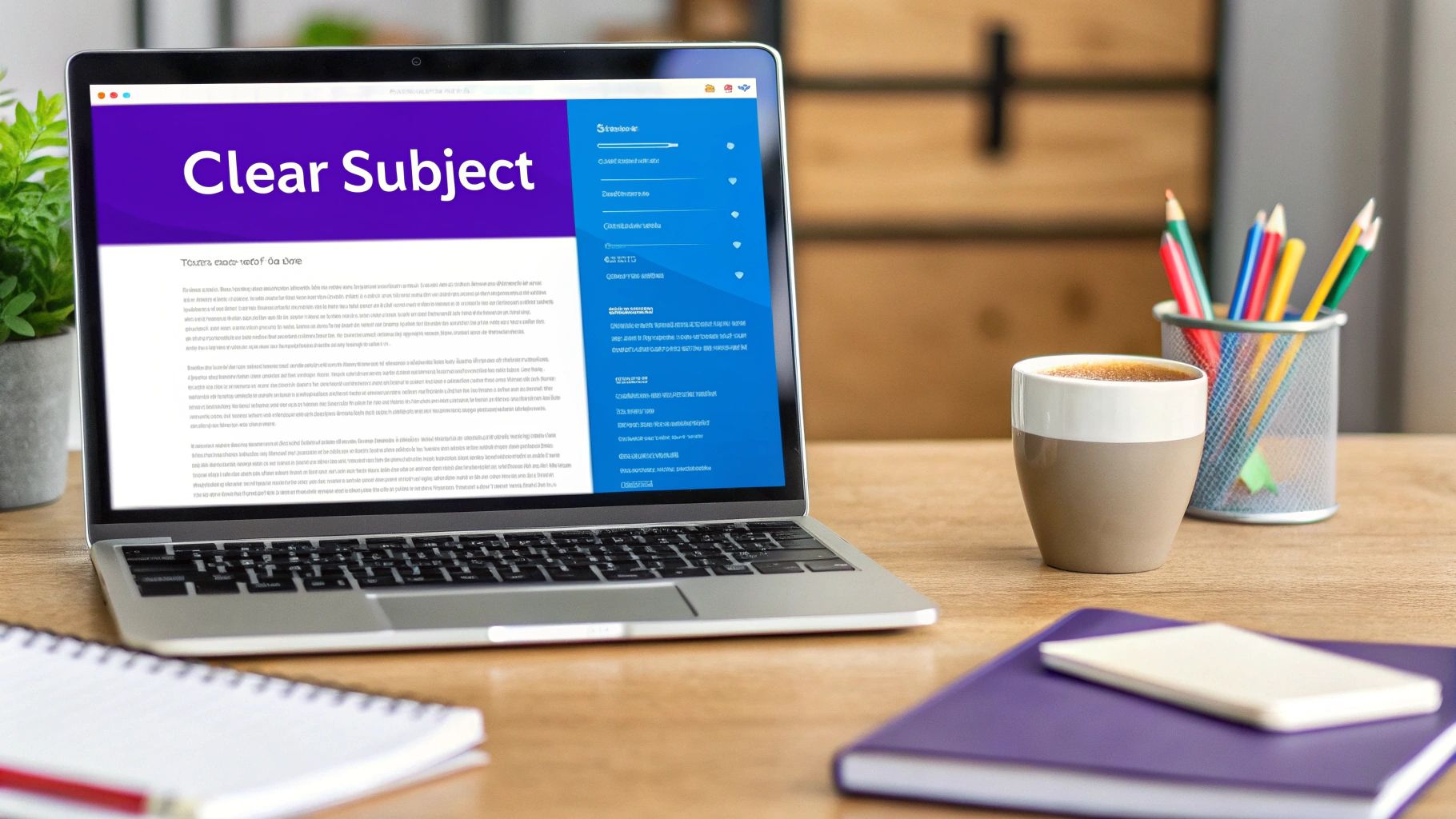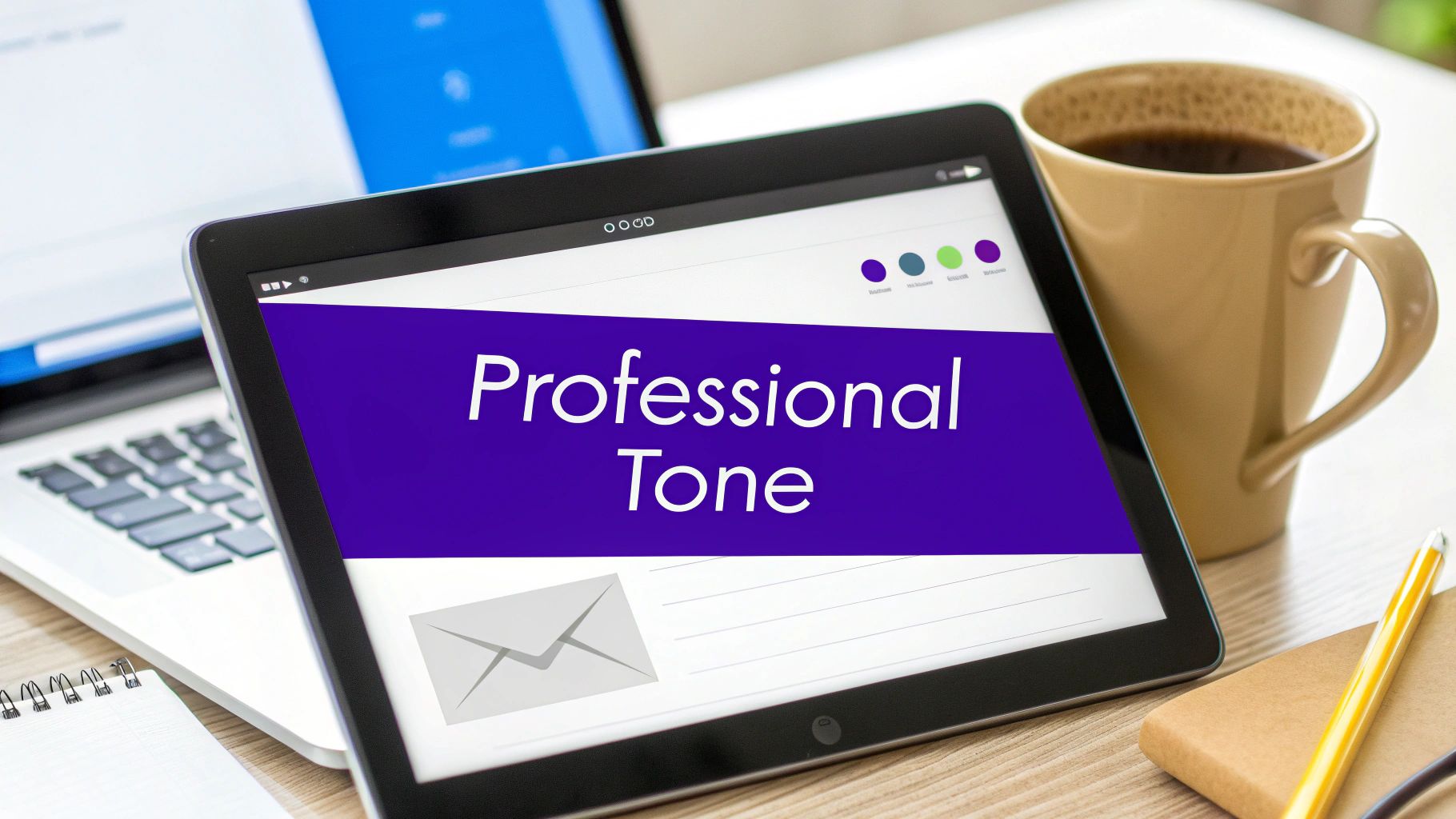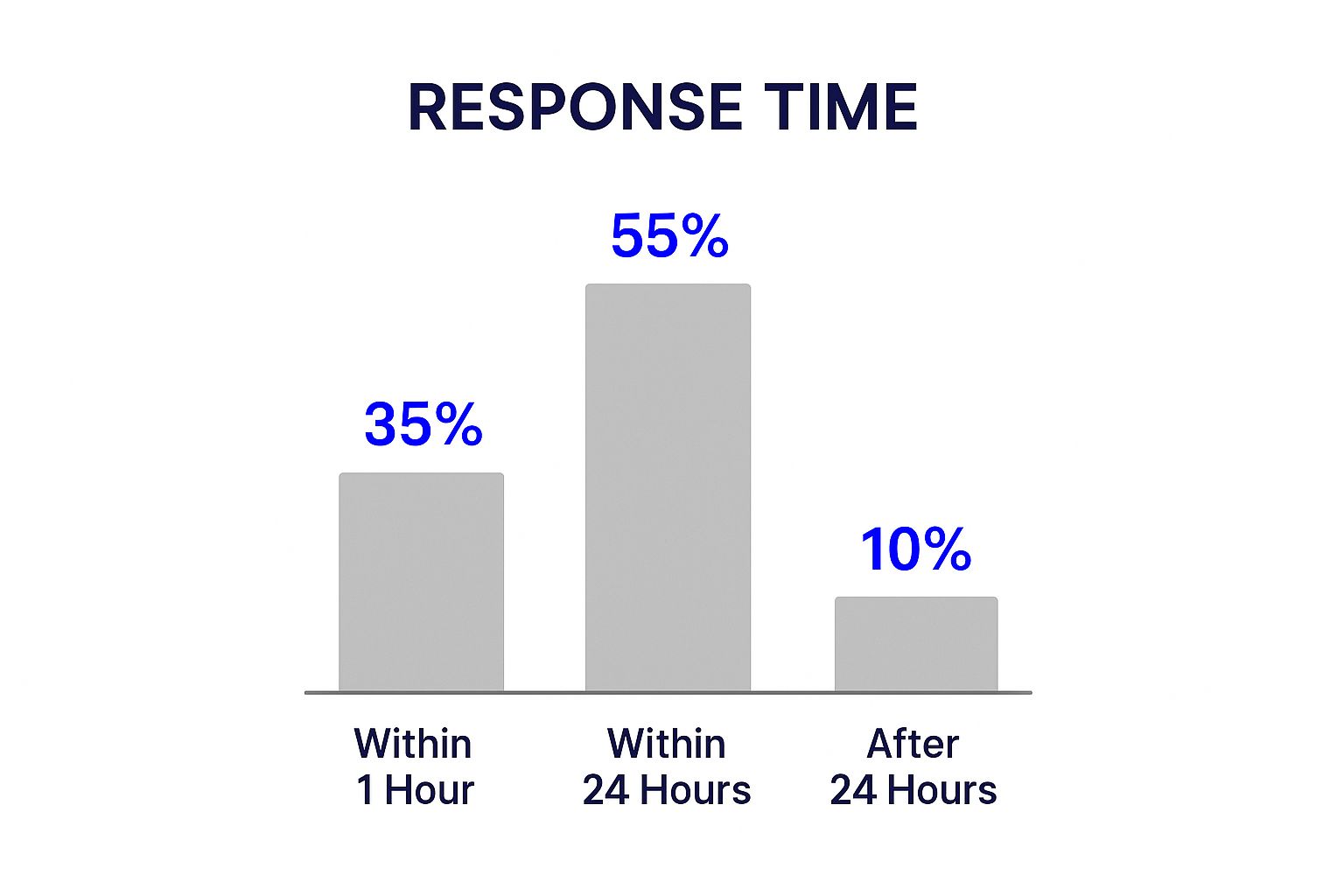How to Answer Emails Professionally: Expert Tips & Strategies
Discover the essential skills for writing professional emails that can significantly impact your career. From crafting engaging subject lines to managing response times, this guide provides actionable insights to elevate your email communication.

Why Professional Email Responses Shape Your Career
The way you respond to emails extends beyond mere communication; these messages function as quiet architects of your professional trajectory, capable of building or damaging your standing.
Each email sent creates a distinct impression, an effect that can spread throughout your professional contacts and subtly shape prospects you may not directly perceive. Consequently, knowing how to answer emails professionally is less about politeness and more about effective career navigation.
 This considerable influence arises because every email acts as a mirror, reflecting your skill, meticulousness, and general professional demeanor.
This considerable influence arises because every email acts as a mirror, reflecting your skill, meticulousness, and general professional demeanor.
Such correspondence frequently represents the main channel through which colleagues, clients, and managers engage with you, establishing a digital handshake that molds how they view your capabilities.
The Unseen Impact of Every Email
It's important to acknowledge that email continues to be a fundamental component of communication in professional settings.
Data from recent 2024 surveys underscore its widespread use, revealing that more than half of all employees, precisely 52.2%, engage with email at least weekly for interactions with coworkers, clients, or vendors. Discover more insights about business writing statistics here.
This regular engagement means every email presents an opportunity to either bolster a favorable professional reputation or inadvertently weaken it.
Experienced individuals are aware of this dynamic and employ email correspondence as a considered method for career progression. They grasp that articulate and well-composed replies can create opportunities, whereas rushed or poorly phrased emails might silently obstruct them.
Consider two applicants with comparable credentials; the individual who conveys information with lucidity, courtesy, and accuracy in their emails frequently obtains a distinct advantage.
The significance of email varies across different sectors, yet its role in professional correspondence remains critical. The following table offers a glimpse into how email usage and preferences manifest across several key industries.
Email Communication Across Industries
Industry breakdown showing email usage frequency and professional communication preferences
Industry | Email Usage % | Primary Communication Method | Average Daily Email Volume (Professional) |
|---|---|---|---|
Technology | 90% | Email, Internal Chat (e.g., Slack, Microsoft Teams) | 50-100 |
Healthcare | 75% | Secure Email, EHR Messaging Systems | 30-60 |
Finance & Banking | 95% | Email, Secure Messaging Platforms | 60-120 |
Education | 85% | Email, Learning Management Systems | 40-80 |
Marketing & Sales | 88% | Email, CRM Integrated Comms | 45-90 |
This data illustrates that while newer communication tools are integrated, email consistently holds a dominant or significant position for formal and documented professional interactions across diverse fields.
The volume and reliance underscore the importance of proficient email skills irrespective of the industry.
Why Your Email Style Can Outshine Technical Skills
There are numerous contexts where the quality of your email correspondence can carry more weight than your technical proficiency. Senior leaders and recruitment managers frequently evaluate communication style alongside formal qualifications to gauge an individual's overall suitability.
An email that is poorly constructed, despite containing technically correct information, might imply:
A deficit in attention to detail
Subpar communication abilities
A disregard for the recipient's time
A general lack of professionalism
In contrast, a professionally drafted email, marked by unambiguous subject lines, correct grammar, a polite tone, and succinct content, conveys capability and consideration. This proficiency in clear communication represents a highly prized soft skill.
The potential advantages embedded in every email exchange are plentiful. Whether responding to a basic question or delivering a detailed project status, each message offers a platform to showcase your dependability and professional approach. Sustained professionalism in your email practices develops into one of your most significant career strengths, forging a positive reputation that can facilitate long-term advancement.
Mastering Response Timing Without Burning Out
The clarity of your message is undoubtedly important, but the timing of your email responses carries substantial weight in shaping perceptions of your professionalism and competence. Indeed, the subtle psychology of response timing can influence your professional standing, sometimes more profoundly than the message content itself.
 Although a swift reply often suggests efficiency, it isn't universally the best approach. In certain contexts, a strategic delay can convey thoroughness and respect, showing that you have properly considered the communication. Achieving this balance is becoming more critical with the ever-increasing volume of electronic correspondence.
Although a swift reply often suggests efficiency, it isn't universally the best approach. In certain contexts, a strategic delay can convey thoroughness and respect, showing that you have properly considered the communication. Achieving this balance is becoming more critical with the ever-increasing volume of electronic correspondence.
The Delicate Balance of Email Response Times
Meeting response time expectations effectively requires careful judgment. Consider that since 2015, the volume of business emails has seen a 3% annual increase.
By 2023, the typical professional managed around 126 business emails daily. This continuous stream of communication contributes to considerable workplace stress; data reveals that two in five employees (40.3%) report feeling anxious while awaiting email replies.
More detailed statistics on business email trends can be found here. Such pressures highlight the necessity for an intelligent email response strategy.
A grasp of these factors is fundamental to understanding how to answer emails professionally. For example, a pressing client inquiry might necessitate an immediate acknowledgment, even if the complete solution requires more time. In contrast, a detailed internal question could be better served by a more deliberate response, allowing for comprehensive investigation and a thoughtfully composed reply.
Setting Realistic Expectations and Boundaries
Effective email management frequently hinges on setting boundaries and clearly defining expectations, both for yourself and for those you communicate with. It's important to recognize that not all emails require an immediate answer. The following methods can be useful:
Batch processing: Allocate distinct periods for reviewing and answering emails, instead of addressing each notification as it arrives. This practice aids in concentrating on other responsibilities.
Prioritization: Employ flags, folders, or task lists to sort emails based on their urgency and significance. After prioritizing, tools such as the Email Writer from Quiky.email can assist in composing effective responses.
Communicate your availability: If a delay is expected, an automated reply or a short message indicating when a more complete response will be provided can effectively manage expectations. For instance: "Thank you for your message. I am currently concentrating on X and will address non-urgent emails by Y."
Sustainable Strategies for Professional Responsiveness
The objective should be sustainable responsiveness rather than constant, immediate availability. Attempting to reply to every email instantly can result in burnout and, paradoxically, a decrease in the quality of your communications. Focus on delivering consistent and dependable replies over mere speed.
Consider your approach to email as an indicator of your broader professional conduct. A thoughtful, timely reply, even if not immediate, typically projects greater competence than a rushed, inaccurate one.
By establishing effective email management systems and valuing your own time, you can adeptly handle response timing without compromising your well-being or other important tasks, thereby reinforcing your image as a considerate and proficient professional.
Crafting Subject Lines That Get Opened
 After establishing the optimal timing for your email, the subsequent crucial factor in professional email communication is the construction of an effective subject line. This short piece of text acts as the initial point of contact, shaping the first impression and significantly influencing whether your message is opened. In a crowded communication space, a well-written subject line is indispensable.
After establishing the optimal timing for your email, the subsequent crucial factor in professional email communication is the construction of an effective subject line. This short piece of text acts as the initial point of contact, shaping the first impression and significantly influencing whether your message is opened. In a crowded communication space, a well-written subject line is indispensable.
The task is made more critical by the statistic that the average open rate for business emails stands at a mere 21.3%. This figure suggests that almost four out of every five emails may remain unopened, highlighting the necessity for a subject line to effectively secure attention. Further email statistics are available here.
A carefully considered subject line conveys respect for the recipient's time and clearly communicates the email's intent, thereby improving the probability of it being read.
The Psychology of a Clickable Subject Line
Grasping what motivates an individual to open an email requires an understanding of certain psychological principles. Subject lines that successfully engage recipients often appeal to fundamental human motivations such as curiosity, the need for closure, or the quest for information. Clarity and conciseness are of utmost importance, enabling recipients to quickly discern the email's main subject.
Furthermore, subject lines that communicate immediate relevance and value generally show higher open rates. When a recipient can swiftly identify the benefit or importance of the email to them, their inclination to open it increases. Key psychological components include:
Urgency (if authentic): Employing phrases such as "Action Required" or "Response Needed by [Date]" can prompt quicker attention.
Specificity: Ambiguous subject lines are often overlooked. For example, "Update on Project Titan" is more effective than a simple "Update."
Personalization: Incorporating the recipient's name or a pertinent specific detail can increase engagement.
Benefit-Oriented Language: Focusing on a positive result or a provided solution can attract interest.
Proven Approaches for Subject Lines
Although no universal solution exists, particular subject line frameworks regularly result in improved open rates. The objective is to be direct and informative, avoiding vagueness or an overly insistent tone. Your subject line should function as a brief encapsulation of your email's primary content or the action it necessitates.
Consider these frequently effective methods:
Action-Oriented: Example: "[Action Required]: Submit Your Q3 Report"
Informative: Example: "Meeting Recap: Key Decisions from 15th May Session"
Question-Based (for brief inquiries): Example: "Quick Question Regarding the Upcoming Deadline?"
Value-Driven: Example: "Feedback on Your Proposal - Next Steps"
Testing various methods is advisable.
For assistance in creating more subject line options, tools such as the Subject Line Generator from Quiky.email can be a useful resource. These tools can offer new perspectives and aid in refining your chosen wording.
Tailoring Your Subject to the Recipient
Ultimately, the most impactful subject lines are those customized for the particular recipient and situation. Communication within an internal team might permit the use of specific project terminology or a less formal style compared to correspondence with a significant client. Examples include:
Internal Team Communication: "Project Falcon: Quick Sync Needed on Task 3.2"
Client Correspondence: "Your Monthly Performance Report for [Company Name] is Ready"
Addressing Urgent Issues: "IMPORTANT: Security Alert - Immediate Action Required"
By meticulously constructing your subject lines, you markedly improve the probability that your professional emails will be opened, reviewed, and addressed. This careful consideration is a key component of proficient communication.
Building Email Structure That Gets Results
A meticulously organized email serves as more than a simple message; it functions as a clear conduit, directing the reader from the opening lines to a specific, desired outcome. Effective email responses are built upon established frameworks, which notably improve readability, understanding, and, critically, the rates of response. Learning how to answer emails professionally centers on converting messages that might otherwise be disorganized into communications that are both succinct and prompt action.
 While the architecture of your message is fundamental, an appreciation of common communication rhythms also offers valuable perspective. The data highlighted indicates prevalent email response times: 35% of replies are sent within one hour, 55% arrive within 24 hours, and the remaining 10% take a longer period.
While the architecture of your message is fundamental, an appreciation of common communication rhythms also offers valuable perspective. The data highlighted indicates prevalent email response times: 35% of replies are sent within one hour, 55% arrive within 24 hours, and the remaining 10% take a longer period.
This information highlights that recipients frequently anticipate prompt replies, and a well-defined structure enables them to digest your timely response with greater efficiency.
The Core Components of a Well-Structured Email
An impactful email generally commences with a clear and purposeful opening. This initial section should immediately inform the recipient of your reason for writing and what the email contains. It is advisable to avoid ambiguous introductions and instead, address the main subject respectfully and directly, establishing a professional tone from the start.
Following this introduction, the body of your email must be organized and concise. For complex details, break the information into shorter paragraphs. Alternatively, use bullet points when listing items or action points. This approach facilitates easier scanning and comprehension, ensuring that your principal messages are not overlooked. Each paragraph should connect logically to the next, constructing a coherent message.
Lastly, every professional email concludes with a strong closing that includes a clear call to action (CTA) or an outline of subsequent steps. Whether you require a reply, a decision, or the recipient to undertake a specific task, this should be stated explicitly. Doing so minimizes uncertainty and improves the probability of achieving your email's objective.
Tailoring Structure for Various Scenarios
The optimal email structure is not a fixed template; it must be adapted to suit the specific context of the communication. For example, when responding to a complaint, the structure might feature an empathetic opening, a body detailing corrective measures, and a closing designed to reassure the customer.
In contrast, for project updates, a structure that presents key accomplishments first, followed by any challenges and then the next steps, generally proves most effective.
Strategic Structuring for Different Business Scenarios
Different types of emails benefit from specific structural designs to optimize their impact. The subsequent table provides a comparison of email structures commonly used in business communications, outlining their typical components and effectiveness.
The table below, titled "Email Response Structure Comparison," examines different email frameworks suited for various business situations and analyzes their potential effectiveness based on their structural elements.
Email Type | Opening Approach | Body Structure | Closing Style | Response Rate |
|---|---|---|---|---|
Complaint Response | Empathetic acknowledgment, state purpose | 1. Apology (if apt) 2. Action steps 3. Reassurance | Offer further help, direct contact | High |
Project Update | Key status summary first (e.g., BLUF) | Bullets for progress, hurdles, next steps | Clear deadlines, invite questions/feedback | Very High |
Networking Outreach | Reference connection, express clear intent | Brief value prop, specific ask (e.g., meeting) | Polite call to action, easy to respond | Moderate to High |
Information Request | Direct & polite statement of need | Numbered/bulleted questions for clarity | Express thanks, offer reciprocation (if apt) | High |
This comparison illustrates that a thoughtfully considered structure clarifies your email's purpose, making it more compelling and thereby increasing the likelihood of engagement.
For instance, just as promotional materials for attractive offerings like Big Island Snorkeling Tours are structured to feature key attractions and essential information clearly, your email should similarly guide the reader smoothly.
By mastering these structural elements, you ensure your professional emails are not merely read, but also acted upon.
Finding Your Professional Email Voice
The impression your emails make extends beyond their organization; the perceived tone significantly influences their reception and your professional image. Achieving an effective professional email voice is not about a rigid adherence to formality or excessive friendliness. Instead, it involves cultivating an authentic voice that fosters solid working relationships and conveys respect.
This equilibrium is fundamental when considering how to answer emails professionally.
This distinct email character, which should thoughtfully combine approachability with assertiveness, needs to come across as natural. Communications that seem contrived or insincere can alienate recipients just as much as those with structural flaws.
The Nuance Between Friendly and Formal
Discovering the appropriate balance between amicable and formal tones in email is an ongoing refinement. The objective isn't to be excessively rigid or, on the other hand, as informal as one might be with a close acquaintance.
True professionalism in electronic correspondence means demonstrating capability and deference while remaining accessible.
For instance, initiating an email with "Hello [Name]," or "Good morning [Name]," often creates a more personal connection than the more impersonal "Dear Sir/Madam," especially in contemporary business settings, without sacrificing decorum.
The aim is to cultivate a communication style that genuinely represents your personality while adhering to professional norms, thereby making your messages more appealing and understandable.
Adapting Your Tone with Authenticity
A significant capability in professional communication is the ability to modify your tone according to different circumstances while preserving your fundamental professional persona. Such flexibility is an indicator of emotional awareness and consideration for the person you are addressing.
Several elements influence this tonal adjustment:
Recipient: The way you address a long-standing coworker will understandably vary from how you communicate with a new important client or a top-level manager. Although respect is paramount in all interactions, established relationships might permit a degree of informality based on shared experiences.
Severity: Pressing issues might call for a more straightforward approach, yet this directness should not be mistaken for curtness or incivility. Even when time is critical, politeness remains essential. For example, "Could you please prioritize this request by EOD?" is a professional way to convey urgency, unlike the unprofessional "Need this NOW."
Cultural Setting: It is important to be aware that methods of communication can differ significantly between cultures. What one culture views as direct and effective, another might interpret as impolite. A basic understanding of these differences can help avoid misinterpretations.
Maintaining Professionalism in Challenging Communications
The most definitive measure of your professional email voice often emerges in how you manage complex discussions or adverse circumstances. It is in these moments that the skill of knowing how to answer emails professionally becomes most apparent. Whether dealing with a grievance, conveying disappointing information, or replying to an impolite email, your tone must stay composed and helpful.
It's significant that in a climate where interpersonal exchanges can become tense—a 2025 Pew Research Center study, for example, found that 47% of participants believed people had grown more impolite—a composed and understanding email tone can substantially reduce friction.
When confronted with uncooperative or negative communication:
Acknowledge the other party's viewpoint or emotions where suitable (e.g., "I understand your frustration regarding...").
Present facts distinctly and impartially, steering clear of emotionally charged wording.
Concentrate on solutions or subsequent actions instead of assigning fault.
Effectively handling these situations by showing understanding when necessary and keeping your composure distinguishes professionals who cultivate connections from those who may unintentionally damage them. Your authentic professional voice thus becomes an important instrument for encouraging constructive and fruitful exchanges, even with difficult topics.
Avoiding Email Mistakes That Damage Relationships
Even when employing a carefully developed professional voice, frequent email missteps can unintentionally create friction and harm professional relationships. Grasping how to answer emails professionally involves a conscious effort to avoid common traps that diminish credibility.
Common Pitfalls That Erode Credibility
Apparent errors such as typos and grammatical gaffes quickly suggest a deficiency in attention to detail. Yet, less obvious problems, including a perceived curt tone or ambiguous phrasing, frequently lead to more significant misinterpretations.
Given that workplace rudeness was reportedly encountered by 62% of employees in 2016, an increase from 25% in 1988, attentive communication is essential. An email composed and sent quickly, for instance, is prone to misreading due to the absence of vocal inflections.
Proactive Proofreading and Recognizing Warning Signs
Cultivating strong proofreading habits is a fundamental practice. Beyond merely using spell-check, reading your email aloud can help identify awkward wording or an unintentional tone. It's beneficial to ask:
Is there a possibility of misinterpretation?
Is my request clearly stated?
Is the tone appropriate for the recipient and the situation?
A short delay before dispatching an email, particularly for messages with sensitive content, can avert considerable problems. This moment of reflection is critical for preventing emails that could have negative consequences.
Navigating Cross-Cultural Email Communication
The international scope of modern business frequently involves emails traversing cultural divides, where communication norms can differ substantially. A style considered direct and efficient in one culture may appear brusque or impolite in another.
For instance, perspectives on formality and directness vary widely, making awareness and adaptation vital for successful cross-cultural email communication. Investigating a recipient's cultural communication style can prevent misunderstandings.
Addressing Mistakes and Rebuilding Trust
Should an email lead to offense or confusion, it is important to address the situation without delay. Corrective actions may include:
Offering a sincere apology if an error was made. An AI Apology Email tool can offer assistance with phrasing.
Providing a clear explanation to dispel any misunderstandings.
Concentrating on finding constructive solutions.
Taking responsibility and communicating transparently are crucial steps in mending relationships and restoring trust, thereby underscoring a commitment to professional conduct.
Advanced Email Strategies for Career Growth
Moving beyond the fundamental aspects of preventing email errors, professionals who excel often convert their email communication into a significant instrument for career progression. This involves employing advanced methods that not only demonstrate competence but also actively cultivate relationships and create pathways to new opportunities. Such a perspective on how to answer emails professionally requires a more profound comprehension of email as a strategic instrument.
Managing intricate email threads, for example, necessitates more than just straightforward replies; it calls for the capacity to condense complex discussions into clear, actionable summaries. In a similar vein, orchestrating group communications proficiently involves steering conversations, making sure all participants are acknowledged, and fostering consensus through thoughtfully constructed messages. Each email exchange, regardless of its routine nature, presents an occasion to exhibit leadership qualities and reinforce professional ties.
Leveraging Templates and Automation Smartly
A frequent challenge is the substantial quantity of email traffic. While email templates can offer considerable time savings, their strategic application is vital to preserve a personal connection. A well-structured template offers a dependable framework, yet it should invariably be adapted to the individual recipient and situation to prevent an impersonal tone. This equilibrium maintains efficiency without forgoing the warmth of authentic communication.
Furthermore, smart automation can liberate substantial cognitive resources. Considering that employees dedicate approximately 5 hours per week to reading and composing emails, which amounts to nearly 10.8 days per year, optimizing this time is essential. With 79% of businesses depending significantly on digital communication tools such as email, employing automation for common tasks—like initial sorting or standardized replies for frequent inquiries—permits a greater focus on more intricate, high-stakes communications. Explore this topic further on email statistics.
The Art of Strategic Follow-Up
The capacity to follow up effectively is another characteristic of a professional who uses email to achieve results. This is a nuanced skill, requiring a balance between persistence and respect for the recipient's schedule.
A well-timed and carefully phrased follow-up email can reactivate a delayed conversation or ensure a critical task is not overlooked. Developing this skill is fundamental for anyone aiming to make a discernible impact.
Turning Emails into Career Catalysts
Ultimately, advanced email competence involves transforming standard exchanges into avenues for career development. This could mean proactively distributing valuable information within a pertinent email thread or using an email update to subtly feature your contributions to a successful project.
Implementing effective email organization systems is also crucial, ensuring you can retrieve information swiftly and respond promptly, even when under pressure.
Sustaining professional excellence in your email correspondence, particularly when dealing with important matters, consistently bolsters your standing as a dependable and skilled individual.
This commitment to quality applies to all types of professional interactions. Even while avoiding email blunders, continuous improvement in client communication is advisable. To learn more, explore these client communication best practices.
Key Takeaways
Essential learnings that you should remember from this article
- Every email shapes your professional reputation and can influence career opportunities.
- Effective email communication requires clarity, structure, and an appropriate tone.
- Managing response times and setting expectations can enhance your professional image.
Practical Tips
Actionable tips you can apply immediately to improve your email performance
Use Clear Subject Lines
Craft subject lines that are specific and convey the email's purpose to increase open rates.
Establish Email Structure
Organize your emails with a clear opening, concise body, and a strong closing call to action.
Set Boundaries for Responses
Manage your email workload by batching responses and setting clear expectations for reply times.
Common Mistakes to Avoid
Pitfalls and misconceptions to avoid when writing persuasive emails
- Neglecting to proofread for typos and grammatical errors can damage credibility.
- Using vague subject lines that fail to capture attention may result in emails being overlooked.
- Failing to adapt tone and formality based on the recipient can lead to misunderstandings.
Tools to Apply These Concepts
Put what you've learned into practice with these specialized tools
Related Content
Continue exploring with these related articles and tools